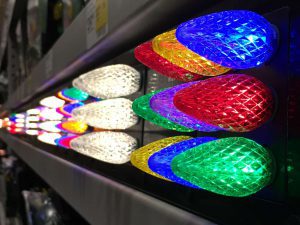 I think we all know there are many benefits to switching to LED lights and we’ll touch on these briefly. But while LED lights are the latest and the greatest, there are a few things you might not know that would be good information to have before you purchase them. The team at Jeremy Electrical put together these lesser known LED lighting tips to help you make a smart purchase when it comes to Christmas lights.
I think we all know there are many benefits to switching to LED lights and we’ll touch on these briefly. But while LED lights are the latest and the greatest, there are a few things you might not know that would be good information to have before you purchase them. The team at Jeremy Electrical put together these lesser known LED lighting tips to help you make a smart purchase when it comes to Christmas lights.
Benefits of LED Lights
LED lights are now available in lots of shapes and sizes and happily, the price has come down from when they were first introduced. The price, on average, for LED Christmas lights is a little more than double that of incandescent lights. Although this may seem steep, LED energy savings can equal their cost over the course of just four seasons, or a full-year of continuous use. LED bulbs offer many benefits and we’ll cover them quickly:
Energy savings – Incandescent bulbs waste a full 90 percent of their energy because it is released as heat. That’s why they get hot to the touch. According to U.S. Department of Energy, LED bulbs use up to 75% less energy, and last 25 times as long. Since Christmas lights are on for hours at a time, switching to LEDs will lower your typical electric bill over the holidays.
Safety – Because they don’t get hot to the touch, LED bulbs are a much lower fire hazard.
Cost Efficient – Because Christmas lights are long-lasting items you can bring out year after year, they will undoubtedly pay for themselves over time through energy savings.
Duration – When it comes to Christmas lights, LEDs burn for about 4,000 hours, while incandescent bulbs lose one or two bulbs per strand before half that time is up. A main reason LEDs are so long lasting is because, unlike incandescents, they don’t have filaments which can heat up and burn out.
4 Tips to Know When Shopping
Pay Attention to the Colors
When LED Christmas lights were first created, the colors looked different from traditional lights. First generation LED Christmas lights weren’t able to match the pure white light of incandescent Christmas lights. They looked much bluer, and many thought they looked colder. Understandably, that was a big turn off for a lot of homeowners. Today’s LED Christmas lights are available in both cool white, if you prefer the blue tone, or warm white, if you prefer more of a golden traditional tone.
You Can’t Mix Bulb Types
Many homeowners want to know if they can replace burned out bulbs in their traditional incandescent light strands with new LED bulbs. The answer is no. First of all, it’s hard to even find replacement LED bulbs. But if you were able to find them, the wiring for your traditional lights is different and not designed to handle LEDs. LED light strings have extremely low wattages and require far less power than the standard incandescent light string. In fact, LED light strings have resistors built into the wiring to reduce and control the amount of current flowing to the bulbs. These resistors keep the power from overloading and frying the LEDs. (The bigger LED bulbs, including C7 and C9 replacement bulbs are self-ballasted, removing the need for a resistor.)
Be Careful of Color Matching
Not every LED diode (the light-emitting chip inside an LED bulb) is the same color or hue. Because LED diodes are produced in large batches or “bins” it becomes necessary to separate them by color. “Binning” is the industry term for the separation of LED diodes by color. Each production bin maintains a slight variation in hue. So if you want your colors to match perfectly, you should purchase several LED light strings at the same time for color consistency.
Look for Interesting Options
LED Christmas lights come in the same shapes and sizes as traditional lights, from C7 and C9 bulbs to mini light strings. They also come in other interesting options including omnidirectional lights that emit shimmering all-around light with a magnified spotlight at the tip that will make your light array sparkle and shine. They also come in wide angle lights that allow for brighter and wider light coverage than traditional lights. You’ll even find LED lights in novelty lighting like holiday candles, lanterns, snowfall lights, ropes, ribbons and more.
If you’re buying new Christmas lights this holiday season, choose LED Christmas lights. They will last for up to 20 years, only use a third of the energy of incandescent mini-lights and 1/100 of traditional C7 or C9 lights, and they’re safer because they don’t get hot. Buy them this year and don’t worry about replacing for at least the next decade or two!






